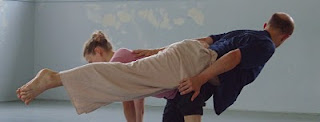I've been taking a look through my notes from last week and really trying to hone in on what's been most effective, surprising and poignant. Here are some ideas:
- I think what Iona Heath says in her book Matters of Life and Death: Key Writings (2008) about patience, and the ability to explore "the depth rather than the duration of time" (p.68) is really important - the piece that I want to make is about the depth and quality of human experience, both in terms of the way humans genuinely behave at crisis moments (in this case the discovery of an unconscious body), but also in terms of how they live their lives prior to those moments, what impact those moments have on their lives afterwards, and how we might be able to represent something of the nature of experience during a moment of unconsciousness
- we have already discovered that time in this piece will be fluid and manipulated in parallel with other alternatives - and that's how we have the potential to open up the briefest moment of unconsciousness or consciousness to find out what might happen there (e.g. what do we see? what do we think/feel and how does that change our behaviour? who or what do we remember? do we experience regret?)
- in saying that I'm reminded that one of the other important things we've discovered is that there are more degrees of consciousness or unconsciousness than we thought
- by about day 3, having worked with being totally passive and fully responsive and changing between the two, Laure, Marie and Tom acknowledged that they were able to experience an absence of panic in dealing with an unconscious body that surprised them (and reminded us of the varying ways in which different cultures deal with death) as well as an honest sense of relief at someone's return to consciousness
- the lessening or absence of panic is where we might find water in the movement vocabulary I think - following the logic for creating movement that we've set up, when we can transition impactive, sudden, indirect movement into a continuous rhythm, there's a sense of relief that begins to look like floating
- not surprisingly, denial or disbelief were common emotions that came up in improvisations based on discovering unconscious bodies, as well as the feeling of not wanting to be left alone by someone

- other, slightly more practical things that have occurred to me concern ways we can use emotions or qualities as a stimulus for movement that is genuine, but not necessarily literal (so we can move into a more imaginative vocabulary, that allows us to shift in rhythm unexpectedly or do something that we wouldn't ordinarily do if confronted with a crisis) - Marie noticed it was increasingly possible to shift between abstract and literal movement when both were in her body following recent improvisation
- I would like to find more ways to emphasise the difference between the lightness and heaviness of responsive/unconscious bodies and also extremes of human behaviour - e.g. I think in order to express the revelation of the absence of panic, it's important to deal with what panic is




It's absolutely fascinating reading your writing about the process. Please do keep writing!
ReplyDelete